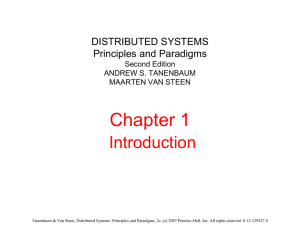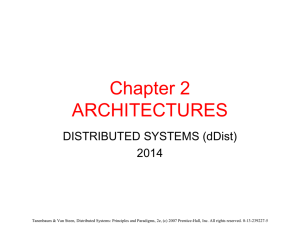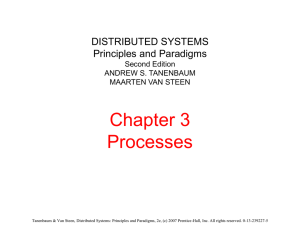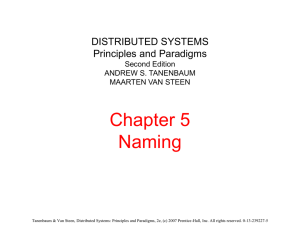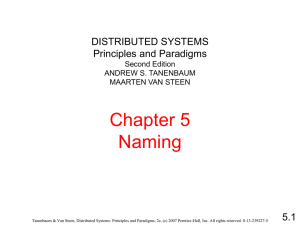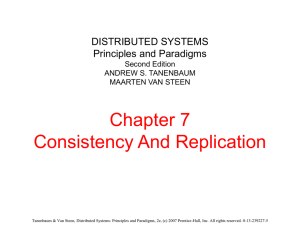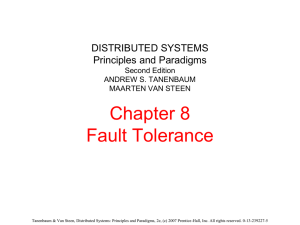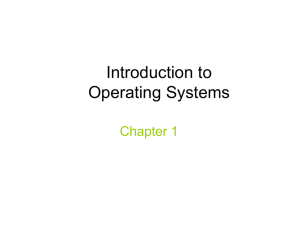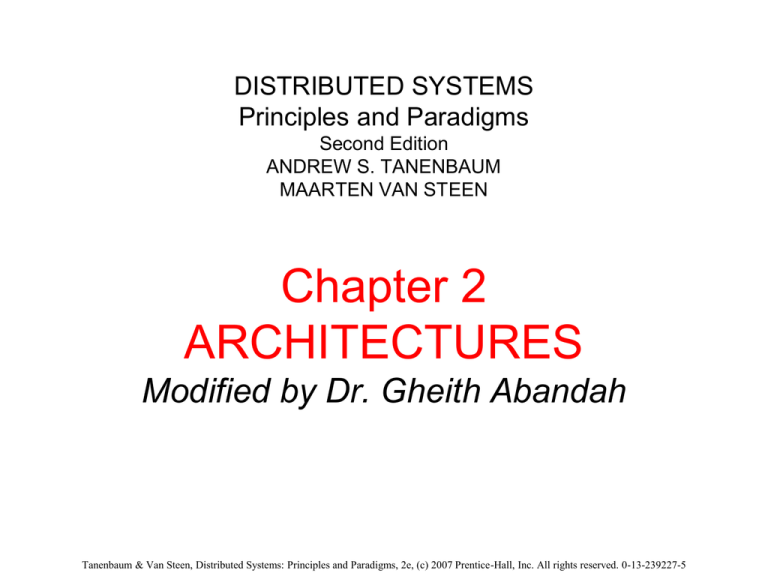
DISTRIBUTED SYSTEMS
Principles and Paradigms
Second Edition
ANDREW S. TANENBAUM
MAARTEN VAN STEEN
Chapter 2
ARCHITECTURES
Modified by Dr. Gheith Abandah
Tanenbaum & Van Steen, Distributed Systems: Principles and Paradigms, 2e, (c) 2007 Prentice-Hall, Inc. All rights reserved. 0-13-239227-5
Overview
•
•
•
•
Architectural styles
System architectures
Architectures versus middleware
Self-management in distributed
systems
Tanenbaum & Van Steen, Distributed Systems: Principles and Paradigms, 2e, (c) 2007 Prentice-Hall, Inc. All rights reserved. 0-13-239227-5
Architectural Styles
Important styles logical/software architecture for
distributed systems:
1.Layered architectures
2.Object-based architectures
3.Event-based architectures
4.Data-centered architectures
Usually organize into logically different
components, and distribute those components
over the various machines.
Tanenbaum & Van Steen, Distributed Systems: Principles and Paradigms, 2e, (c) 2007 Prentice-Hall, Inc. All rights reserved. 0-13-239227-5
1. Layered architectural style
Tanenbaum & Van Steen, Distributed Systems: Principles and Paradigms, 2e, (c) 2007 Prentice-Hall, Inc. All rights reserved. 0-13-239227-5
2. Object-based architectural style
Tanenbaum & Van Steen, Distributed Systems: Principles and Paradigms, 2e, (c) 2007 Prentice-Hall, Inc. All rights reserved. 0-13-239227-5
3. Event-based architectural style
Publish/subscribe systems [decoupled in space].
Published events reach subscribed processes.
Tanenbaum & Van Steen, Distributed Systems: Principles and Paradigms, 2e, (c) 2007 Prentice-Hall, Inc. All rights reserved. 0-13-239227-5
4. Shared data-space architectural
style
Shared dataspace [decoupled in space and time]
Tanenbaum & Van Steen, Distributed Systems: Principles and Paradigms, 2e, (c) 2007 Prentice-Hall, Inc. All rights reserved. 0-13-239227-5
System Architectures
Important styles of hardware architecture for
distributed systems:
1.Centralized architectures
1. Basic client-server
2. Application layering
3. Multi-tiered architectures
2.Decentralized architectures
1. Structured P2P
2. Unstructured P2P
3. Hybrid P2P
3.Hybrid architectures
Tanenbaum & Van Steen, Distributed Systems: Principles and Paradigms, 2e, (c) 2007 Prentice-Hall, Inc. All rights reserved. 0-13-239227-5
1. Centralized Architectures
Basic client-server model (1)
•
•
•
•
There are processes offering services (servers)
There are processes that use services (clients)
Clients and servers can be on different machines
Clients follow request/reply model wrt to using services
Tanenbaum & Van Steen, Distributed Systems: Principles and Paradigms, 2e, (c) 2007 Prentice-Hall, Inc. All rights reserved. 0-13-239227-5
1. Centralized Architectures
Basic client-server model (2)
•
Connectionless protocols
•
•
•
•
Request/reply
On time out, resend
May create problems
Connection-oriented protocols
•
Set up and tear down connections
Tanenbaum & Van Steen, Distributed Systems: Principles and Paradigms, 2e, (c) 2007 Prentice-Hall, Inc. All rights reserved. 0-13-239227-5
1. Centralized Architectures
Application Layering (1)
Traditional three-layered view
•
•
•
User-interface layer contains units for an
application’s user interface
Processing layer contains the functions of an
application, i.e., without specific data
Data layer contains the data that a client wants to
manipulate through the application components
This layering is found in many distributed information
systems, using traditional database technology and
accompanying applications.
Tanenbaum & Van Steen, Distributed Systems: Principles and Paradigms, 2e, (c) 2007 Prentice-Hall, Inc. All rights reserved. 0-13-239227-5
1. Centralized Architectures
Application Layering (2)
Example: The simplified organization of an Internet search engine
into three different layers.
Tanenbaum & Van Steen, Distributed Systems: Principles and Paradigms, 2e, (c) 2007 Prentice-Hall, Inc. All rights reserved. 0-13-239227-5
1. Centralized Architectures
Multitiered Architectures (1)
•
•
•
Single-tiered: dumb terminal/mainframe
configuration
Two-tiered: client/single server configuration
Three-tiered: each layer on separate
machine
Tanenbaum & Van Steen, Distributed Systems: Principles and Paradigms, 2e, (c) 2007 Prentice-Hall, Inc. All rights reserved. 0-13-239227-5
1. Centralized Architectures
Multitiered Architectures (2)
The simplest organization is to have only two
types of machines:
• A client machine containing only the
programs implementing (part of) the userinterface level
• A server machine containing the rest,
–
the programs implementing the processing and
data level
Tanenbaum & Van Steen, Distributed Systems: Principles and Paradigms, 2e, (c) 2007 Prentice-Hall, Inc. All rights reserved. 0-13-239227-5
1. Centralized Architectures
Multitiered Architectures (3)
Alternative client-server organizations
Examples: (a) terminal, (c) forms, (e) PC, (e) PC with cache
Tanenbaum & Van Steen, Distributed Systems: Principles and Paradigms, 2e, (c) 2007 Prentice-Hall, Inc. All rights reserved. 0-13-239227-5
1. Centralized Architectures
Multitiered Architectures (4)
Three-tiered system: An example of a server acting as client.
Tanenbaum & Van Steen, Distributed Systems: Principles and Paradigms, 2e, (c) 2007 Prentice-Hall, Inc. All rights reserved. 0-13-239227-5
2. Decentralized Architectures
We have been seeing recently a tremendous growth in
peer-to-peer systems.
1.Structured P2P: nodes are organized following a
specific distributed data structure
2.Unstructured P2P: nodes have randomly selected
neighbors
3.Hybrid P2P: some nodes are appointed special
functions in a well-organized fashion
In virtually all cases, we are dealing with overlay networks: data is
routed over connections setup between the nodes (cf. applicationlevel multicasting)
Tanenbaum & Van Steen, Distributed Systems: Principles and Paradigms, 2e, (c) 2007 Prentice-Hall, Inc. All rights reserved. 0-13-239227-5
2. Decentralized Architectures
Structured P2P (1)
Organize the nodes in a
structured overlay
network such as a
logical ring, and make
specific nodes
responsible for services
based only on their ID
The system provides an
operation
LOOKUP(key) that will
efficiently route the
lookup request to the
associated node.
DHT: Distributed hash table
Tanenbaum & Van Steen, Distributed Systems: Principles and Paradigms, 2e, (c) 2007 Prentice-Hall, Inc. All rights reserved. 0-13-239227-5
2. Decentralized Architectures
Structured P2P (2)
Example: The mapping of
data items onto nodes in
content addressable
network (CAN).
Organize nodes in a ddimensional space and
let every node take the
responsibility for data in
a specific region.
Tanenbaum & Van Steen, Distributed Systems: Principles and Paradigms, 2e, (c) 2007 Prentice-Hall, Inc. All rights reserved. 0-13-239227-5
2. Decentralized Architectures
Structured P2P (3)
Splitting a region when a
node joins.
Tanenbaum & Van Steen, Distributed Systems: Principles and Paradigms, 2e, (c) 2007 Prentice-Hall, Inc. All rights reserved. 0-13-239227-5
2. Decentralized Architectures
Unstructured P2P
Many unstructured P2P systems attempt to maintain a random
graph (overlay network).
•
Randomly construct list of neighbors
•
Randomly distribute data
•
Flood the network with search queries
Tanenbaum & Van Steen, Distributed Systems: Principles and Paradigms, 2e, (c) 2007 Prentice-Hall, Inc. All rights reserved. 0-13-239227-5
2. Decentralized Architectures
Hybrid P2P, Superpeers
A hierarchical organization of nodes into a superpeer network.
The peers maintain the data index.
Tanenbaum & Van Steen, Distributed Systems: Principles and Paradigms, 2e, (c) 2007 Prentice-Hall, Inc. All rights reserved. 0-13-239227-5
3. Hybrid Architectures
Hybrid Architectures: Client-server combined with P2P
1.Edge-server systems
2.Collaborative distributed systems
Tanenbaum & Van Steen, Distributed Systems: Principles and Paradigms, 2e, (c) 2007 Prentice-Hall, Inc. All rights reserved. 0-13-239227-5
3. Hybrid Architectures
Edge-Server Systems
Edge-server architectures, which are often used in Content
Delivery Networks, e.g. Internet.
Viewing the Internet as consisting of a collection of edge servers.
Tanenbaum & Van Steen, Distributed Systems: Principles and Paradigms, 2e, (c) 2007 Prentice-Hall, Inc. All rights reserved. 0-13-239227-5
3. Hybrid Architectures
Collaborative Distributed Systems (1)
• Client-server to join
• Then decentralized collaboration
• Often tit-for-tat
Tanenbaum & Van Steen, Distributed Systems: Principles and Paradigms, 2e, (c) 2007 Prentice-Hall, Inc. All rights reserved. 0-13-239227-5
3. Hybrid Architectures
Collaborative Distributed Systems (2)
BitTorrent example: Once a node has identified where to
download a file from, it joins a swarm of downloaders who in
parallel get file chunks from the source, and distribute these
chunks amongst each other.
Get chunks from multiple nodes.
Tanenbaum & Van Steen, Distributed Systems: Principles and Paradigms, 2e, (c) 2007 Prentice-Hall, Inc. All rights reserved. 0-13-239227-5
3. Hybrid Architectures
Collaborative Distributed Systems (3)
Globule collaborative content distribution network
allows replicating web pages on multiple
servers, components:
• A component that can redirect client requests
to other servers.
• A component for analyzing access patterns.
• A component for managing the replication of
web pages.
Tanenbaum & Van Steen, Distributed Systems: Principles and Paradigms, 2e, (c) 2007 Prentice-Hall, Inc. All rights reserved. 0-13-239227-5
Architectures Versus Middleware
•
•
Where does the middleware fit in the arch.?
Middleware solutions:
•
•
•
Object-based architectural style, e.g., CORBA
Event-based architectural style, e.g., TIB
In many cases, distributed
systems/applications are developed according
to a specific architectural style. The chosen
style may not be optimal in all cases,
therefore, need to (dynamically) adapt the
behavior of the middleware.
Tanenbaum & Van Steen, Distributed Systems: Principles and Paradigms, 2e, (c) 2007 Prentice-Hall, Inc. All rights reserved. 0-13-239227-5
Architectures Versus Middleware
Solution: Interceptors
Intercept the usual
flow of control
when invoking a
remote object.
At request level, can
handle
replications of
B.
At message level,
can fragment
the message
containing large
“value”.
Tanenbaum & Van Steen, Distributed Systems: Principles and Paradigms, 2e, (c) 2007 Prentice-Hall, Inc. All rights reserved. 0-13-239227-5
General Approaches to Adaptive
Software
•
•
•
Separation of concerns: Try to separate extra functionalities
and later weave them together into a single implementation.
But how to handle a concern such as security?!
Computational reflection: Let a program inspect itself at
runtime and adapt/change its settings dynamically if
necessary → mostly at language level and applicability
unclear.
Component-based design: Organize a distributed application
through components that can be dynamically replaced when
needed → highly complex, also many intercomponent
dependencies.
Tanenbaum & Van Steen, Distributed Systems: Principles and Paradigms, 2e, (c) 2007 Prentice-Hall, Inc. All rights reserved. 0-13-239227-5
Self-managing Distributed Systems
•
Automatic adaptation: need to be taken into
account:
•
•
•
•
•
Self-configuration
Self-managing
Self-healing
Self-optimizing
Self-*
Tanenbaum & Van Steen, Distributed Systems: Principles and Paradigms, 2e, (c) 2007 Prentice-Hall, Inc. All rights reserved. 0-13-239227-5
Self-managing Distributed Systems
The Feedback Control Model
The logical organization of a feedback control system.
In many cases, self-* systems are organized as a feedback
control system.
Tanenbaum & Van Steen, Distributed Systems: Principles and Paradigms, 2e, (c) 2007 Prentice-Hall, Inc. All rights reserved. 0-13-239227-5
Self-managing Distributed Systems
Example 1: Astrolabe
•
•
•
•
•
For system monitoring in large distributed
system.
Hierarchy of zones to collect information and
communicate
Hosts run special agent
Supports queries similar to SQL
Gossiping protocol to exchange info
Tanenbaum & Van Steen, Distributed Systems: Principles and Paradigms, 2e, (c) 2007 Prentice-Hall, Inc. All rights reserved. 0-13-239227-5
Example 1: Systems Monitoring
with Astrolabe
Data collection and information aggregation in Astrolabe
Tanenbaum & Van Steen, Distributed Systems: Principles and Paradigms, 2e, (c) 2007 Prentice-Hall, Inc. All rights reserved. 0-13-239227-5
Example 2: Selecting Replication
Strategies in Globule (1)
• The edge-server model assumed by Globule
• Globule origin server collects traces and does what-if analysis
by checking what would have happened if page P would have
been placed at edge server S.
• Many strategies are evaluated, and the best one is chosen.
Tanenbaum & Van Steen, Distributed Systems: Principles and Paradigms, 2e, (c) 2007 Prentice-Hall, Inc. All rights reserved. 0-13-239227-5
Example 2: Selecting Replication
Strategies in Globule (2)
The dependency between prediction
accuracy and trace length
Tanenbaum & Van Steen, Distributed Systems: Principles and Paradigms, 2e, (c) 2007 Prentice-Hall, Inc. All rights reserved. 0-13-239227-5
Example 3: Automatic Component
Repair Management in Jade
In clusters, need to add/remove components at
runtime.
Each node/server has components, failure detectors,
and node manager.
Steps required in a repair procedure:
1.
2.
3.
4.
Terminate every binding between a component on a non-faulty
node, and a component on the node that just failed.
Request the node manager to start and add a new node to the
domain.
Configure the new node with exactly the same components as
those on the crashed node.
Re-establish all the bindings that were previously terminated.
Tanenbaum & Van Steen, Distributed Systems: Principles and Paradigms, 2e, (c) 2007 Prentice-Hall, Inc. All rights reserved. 0-13-239227-5

